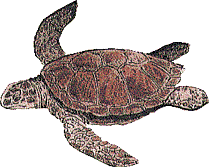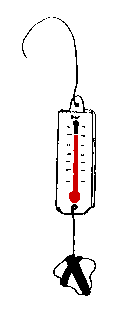
At this station your team will take air and water temperature measurements
and learn what these measurements indicate about your aquatic site. Water
temperature affects the ability of oxygen and salt to stay dissolved in water.
Water temperatures greater than 20 degrees C (about 66 degrees F) do not contain as much
dissolved oxygen as those below 20 degrees C. For salt content, the pattern is
similar - as the temperature increases from 15 degrees to 30 degrees C (about 57 degrees to 84 degrees F),
the salinity decreases. Air temperature is also an important characteristic of
an aquatic site, because it gives scientists an insight regarding weather factors
which will eventually increase or decrease the water temperature.
Materials
For the Pre-Field station:
- 4 Celsius thermometers
- Cup of hot water
- Cup of cold water
For the field station:
- 4 Celsius thermometers
- Fishing line, several meters
- Duct tape
- Your team's copy of Master 4a, "Baseline Study and Possible Human Impact
Assessment Form"
Methods
Pre-Field Experiment:
- Hold the thermometer in the air until you can take a steady temperature
reading. Record the results in your JASON Journal.
- Hold the thermometer in the cup of hot water until you can take a steady
temperature reading. Record the results in your JASON Journal.
- Hold the thermometer in the cup of cold water until you can take a steady
temperature reading. Record the results in your JASON Journal.
In the field, you will consider these readings along with measurements taken
from other stations to determine the ability of your aquatic site to support life.
Field Experiment

- Hold the thermometer in the air until you can take a steady temperature
reading. Record the reading on Master 4a.
- Hold the thermometer in the water until you can take a steady temperature
reading. Record the reading on Master 4a.
- If you want to get a water temperature reading at a deeper spot, you can
modify your thermometer as follows: Cut a piece of fishing line several
meters long. About 15 cm (6 in) from one end of the line, tie the fishing
line around a small rock or large pebble. Then wrap a piece of duct tape
around the line and rock to hold them in place. Now tie the thermometer
to the very end of the line (15 cm from the rock).
Also secure the
thermometer with a piece of duct tape. Holding the opposite end of the
line, cast the thermometer into the water. The rock will provide the weight
necessary to submerge the thermometer. Keep the thermometer submerged
for about as long as it took to obtain a steady reading in shallower water.
Record the results on Master 4a.
Conclusions
After you have completed both the Pre-Field and Field Experiments, discuss
the following questions within your research team and record your answers
in your JASON Journal.
- How are water and air temperatures good indicators of a site's ability to
support life? How would sites with colder water likely differ from those
with warmer water?
- How does air temperature relate to water temperature?
- Think about some of the measurements you have taken at other stations at
the aquatic site. How do air and water temperature relate to these other
measurements?
- What new questions do you have about how air and water temperatures
affect aquatic environments?
- Look for more answers to your questions in the JASON Online Systems,
the library, and science textbooks.

Return to the Aquatic Field Investigation
JASON VII Home Page


JASON Project Homepage ||
Teachers' Guide ||
Students' Corner ||
Search
Gene Carl Feldman
(gene@seawifs.gsfc.nasa.gov)
(301) 286-9428
Todd Carlo Viola, JASON Foundation for Education (todd@jason.org)
Revised: 3 Nov 1995

![]()
![]()